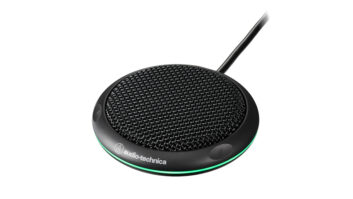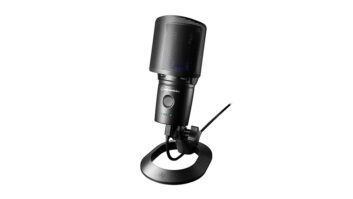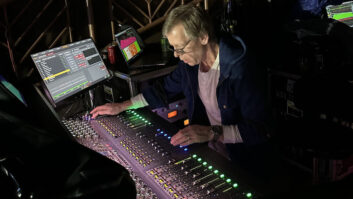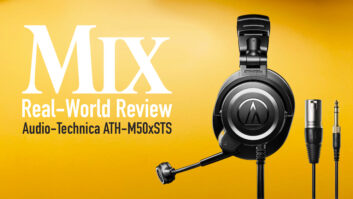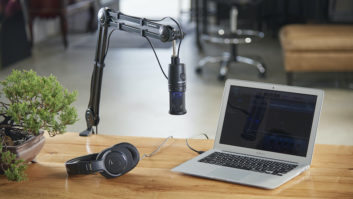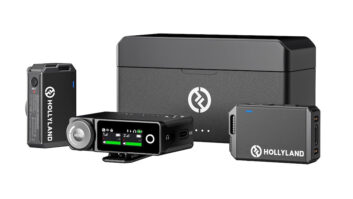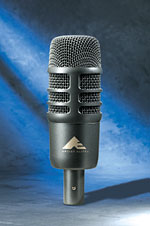
A totally new, innovative mic design, the Audio-Technica AE2500 usesspecifically designed dynamic and condenser cardioid transducersmounted side-by-side in perfect phase alignment in a single microphonebody. This dual-element approach offers audio engineers a kind of“remote control” at the mixer position. Whether you mix themic’s two elements together or record them on separate tracks, the$699/list AE2500 offers many creative processing options when miking LFsources such as kicks, floor toms and bass cabinets.
The sturdy, all-metal windscreen cover of this 13-ounce mic unscrewsto reveal two all-new A-T capsules mounted on a rigid, polished,nickel-plated metal support structure to withstand excessive shock andvibration. The dynamic element’s neodymium magnet structure isspecifically designed and tuned to capture the beater’s attack. Thecompanion condenser element has a self-polarized (electret),11mm-diameter capsule with a 2-micron-thick diaphragm and is housed ina special structure to help reduce high-SPL distortion at subsonicfrequencies.
The build quality is excellent: I’m sure that the AE2500 would standup to the “drop-kick” test that any mic should pass beforebeing placed near a drummer. The AE2500 comes with an AT8471 isolationclamp mount and a 5-pin XLR connector with mating plug, and a 16.5-footcord that fans out to two standard XLR-3 plugs. Thoughtfully, the endsare marked “dynamic” and “condenser” so youknow which requires phantom power. Onboard electronics for thecondenser element include a switchable -10dB pad and a -12dB/octave,80Hz highpass filter.
IN THE STUDIO
My first look at the mic was for a drum-sample session in which wesampled two different bass drums. Besides the AE2500, I used an AKG D112 and a Shure Beta 52 as a reference, not as an A/B test. The kickdrums were an 18-inch 1971 Slingerland floor tom (with a DanmarPercussion Tom Kick Riser conversion) and a clear Remo Emperor head. Ialso recorded a 1967 22-inch Ludwig kick with a Remo Powerstroke 3head. Both drums had new single Remo heads with Remo Flam Slam patches.We also used a Danmar felt beater. On all tests, the mic was centeredexactly on the shell’s diameter, pointed at the beater, with half ofthe mic’s body inside the drum and half outside.
My recording setup was a PreSonus M80 8-channel preamp and a ProTools|HD system set to 24-bit/192 kHz. No processing was used. DrummerJimmy Hunter played snare and hi-hat for some of the recordings toassess differences in the amount of leakage.
Comparing the AE2500 to two really good dynamic kick mics (AKG D 112and Shure Beta 52), I noticed that its dynamic element had more outputthan both and less snare/hat leakage. The AE2500’s dynamic captured theattack of the beater in a balanced way compared to the Shure’saccentuated top end. The D 112 was smooth-sounding in the highs, but Ihad to add top-end EQ later in the mix. I found the AE2500 dynamic hadbetter upper-bass response than the Beta 52. While the D 112 soundedgood on both kicks, I couldn’t get the presence I got with the AE2500dynamic.
The Beta 52 offers more subsonic level than either the D 112 or theAE2500 dynamic; adding in the AE2500 condenser element quickly changedthat! The condenser produces a deeper and rounder sound quality thanthe dynamic, and I found using the -10dB pad produced a consistentlyhotter digital recording level than without it. Compressing just thedynamic half and mixing in the condenser unprocessed, I sure found acool new bass drum sound.
I loaned the AE2500 to engineer Erik Zobler, who was tracking artistWill Downing. Zobler put the AE2500 on snare, where he also had a Beta56 EQ’d with a Pultec with about +8 dB at 10kHz shelf. Using the AE2500and mixing the two outputs equally together (the condenser with -10dBpad in), he got a good-sounding “crack” from the snarewithout EQ.
Next up, at prerecord sessions at Capitol Records in Hollywood forthe 2003 Academy Awards, engineers Tom and Dan Vacari used the AE2500along with the Shure Beta 52 on drummer Harvey Mason’s kick drum. Theygot every sound needed for all the different music styles required forthat show.
A NEW TREND
The AE2500 leads what I hope is a new trend in mic design, where now— beyond the exact mic choice and placement — a new levelof microphone control is possible. I liked the option of mixing andprocessing the mic’s two elements with perfect phase integrity for acohesive bass or snare drum track that you just can’t get using twoseparate mics.
Thanks go to Dan and Tom Vacari, Erik Zobler, Jimmy Hunter, Cazador,LAFX and Capitol Studios.
Audio-Technica, 330/686-2600, www.audio-technica.com.

